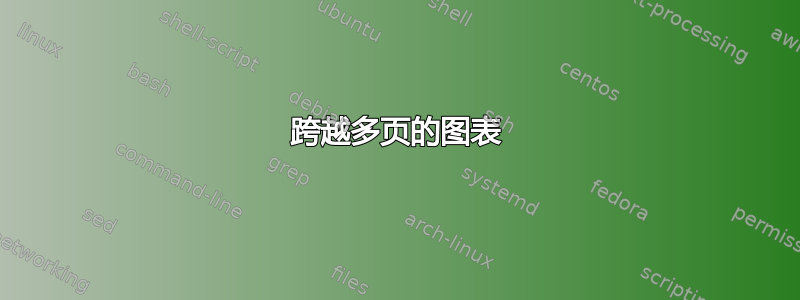
我正在尝试让子图跨越多页。我已经声明了一个新的浮动环境,因为这些是补充图。我正在使用“subcaption”包来获得子图。但是,我不知道如何让子图跨越多页。在下面的最小可重现示例中,图 2 的所有三个子图最终都出现在同一页上。我尝试在第二个子图后添加\newpage或\clearpage,但这没有任何作用。(您可以 \clearpage在我的示例中根据需要打开或关闭该命令)。
有人可能对这些图形如何跨越多页有什么建议吗?
谢谢。
\documentclass[a4paper,10pt]{article}
\usepackage{graphicx}
\usepackage{subcaption}
\usepackage{newfloat}
\DeclareFloatingEnvironment[name={Supplementary Figure},fileext=lsf,listname={List of Supplementary Figures}]{suppfigure}
\begin{document}
%\listoffigures
%\listofsuppfigures
%\clearpage
\section*{Supplementary Figures}
\begin{suppfigure}[h]
\noindent
\includegraphics[width=\textwidth]{RA_plot.png}
\caption{\textbf{Relative abundance of species across all communities.} Area plots where the area of each color represents the relative abundance of a particular species at one of the five sampling points listed on the x-axis. Each plot is a different community, where the initials of species in the community are located on the upper facet label. Area values are the average of the number of replicates for which a community and thus the respective species were replicated in the chemostat.}
\label{fig:Area-Plot-Abundance}
\end{suppfigure}
\begin{suppfigure}
\subcaptionbox{}{\includegraphics[width=\textwidth]{FIG_FGSLAA.png}}
\subcaptionbox{}{\includegraphics[width=\textwidth]{FIG_FRU.png}}
%\clearpage
\subcaptionbox{}{\includegraphics[width=\textwidth]{FIG_LAC.png}}
\caption{\textbf{Phenotypic Evolution of Species On the Different Nutrient Groups.} Changes to evolved growth rates split and analyzed via each nutrient group and species. Focal species' data are displayed row wise, and each plot in the row displays the same data, where the column view highlights potential species interactions, as determined the step-wise linear regression models. Blue points indicate that the focal species in the row view interacted with and was present with the competitor species in the column view. Shaded subplots represent a significant species interaction. Blue shade indicates the evolved growth rate of the focal species was significantly higher in the presence, when compared to the absence, of the competitors species; red shade indicates the evolved growth rate of the focal species was significantly lower in the in the presence of the competitor species. The horizontal dashed line indicates the evolved growth rate of the focal species ancestor.}
\label{fig:Area_Plot_Abundance}
\end{suppfigure}
\end{document}
答案1
尝试suppfigure对最后三幅图像使用两个环境,使用您自己的环境。
评论后更新。
\documentclass[a4paper,10pt]{article}
\usepackage{graphicx}
\usepackage{subcaption}
\usepackage{newfloat}
\DeclareFloatingEnvironment[name={Supplementary Figure},fileext=lsf,listname={List of Supplementary Figures}]{suppfigure}
\begin{document}
%\listoffigures
%\listofsuppfigures
%\clearpage
\section*{Supplementary Figures}
\begin{suppfigure}[h]
\noindent
\includegraphics[width=\textwidth]{example-image}
\caption{\textbf{Relative abundance of species across all communities.} Area plots where the area of each color represents the relative abundance of a particular species at one of the five sampling points listed on the x-axis. Each plot is a different community, where the initials of species in the community are located on the upper facet label. Area values are the average of the number of replicates for which a community and thus the respective species were replicated in the chemostat.}
\label{fig:Area-Plot-Abundance}
\end{suppfigure}
\begin{suppfigure}\ContinuedFloat % do not increse the figure counter <<<<<<<<<<<<<<
\subcaptionbox{}{\includegraphics[width=\textwidth]{example-image-a}}
\subcaptionbox{}{\includegraphics[width=\textwidth]{example-image-b}}
\end{suppfigure}
\begin{suppfigure}
\subcaptionbox{}{\includegraphics[width=\textwidth]{example-image-c}}
\caption{\textbf{Phenotypic Evolution of Species On the Different Nutrient Groups.} Changes to evolved growth rates split and analyzed via each nutrient group and species. Focal species' data are displayed row wise, and each plot in the row displays the same data, where the column view highlights potential species interactions, as determined the step-wise linear regression models. Blue points indicate that the focal species in the row view interacted with and was present with the competitor species in the column view. Shaded subplots represent a significant species interaction. Blue shade indicates the evolved growth rate of the focal species was significantly higher in the presence, when compared to the absence, of the competitors species; red shade indicates the evolved growth rate of the focal species was significantly lower in the in the presence of the competitor species. The horizontal dashed line indicates the evolved growth rate of the focal species ancestor.}
\label{fig:Area_Plot_Abundance}
\end{suppfigure}
\end{document}



